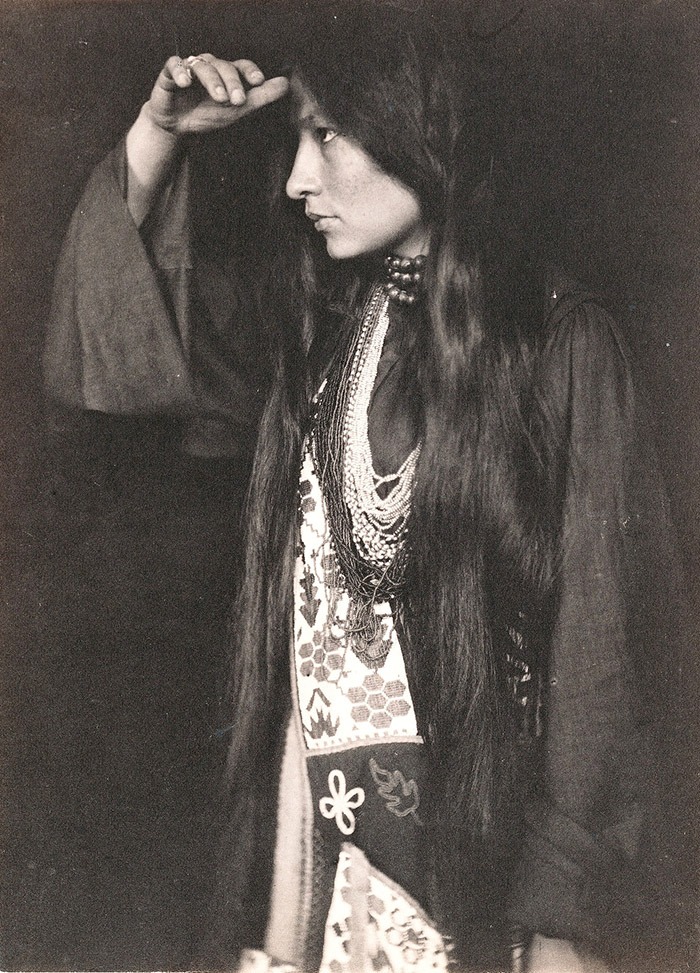
Zitkála-Šá, by Gertrude Käsebier, 1898
As part of our Score Club Special edition project, OrchestraOne will be doing composer spotlights in-between our larger Score Club blasts. These spotlights will highlight the contributions and lives of African American and Indigenous American composers and musicians. All of these spotlights are brought to you by Emma Schmiedecke, an OrchestraOne cellist, and scholar.
Zitkala-Ša (translation “Red Bird”), English name Gertrude Simmons, violinist and librettist, was born on the Yankton Sioux Agency Reservation, South Dakota to a Yankton Sioux mother and a Euro-American father, adopting the native name Zitkala-Ša in her teens. Known for co-founding the National Council of American Indians in 1926 and her political activism on behalf of American native peoples, she was a pioneer for Native Americans in American classical music throughout her life.Like many of Native American descent in late 19th-century America, Zitkala-Ša was sent to a missionary school run by caucasian Quakers, the White’s Indiana Manual Labor Institute in Wabash, Indiana, whose goal was to educate white, black, and Native American children from what they considered “poor backgrounds.”
Zitkála-Šá, by Gertrude Käsebier, 1898

Zitkala-Ša, by Joseph T. Keiley, 1898. Currently hanging at the National Portrait Gallery at the Smithsonian.
Zitkala-Ša later wrote that they tried to strip her of her Native American heritage, forcing her to pray in the Quaker tradition and cutting her long hair, though she did take pleasure in learning how to read, write, and play the violin. In her late teens, Zitkála-Ša chose to attend Earlham College in Richmond, Indiana and, in 1897, became the first Native American to enroll at an American music conservatory, the New England Conservatory of Music in Boston, Massachusetts, as a violin major from 1897-1899. After graduating, she took a position at Carlisle Indian Industrial School in Pennsylvania teaching music and played violin with the school’s Carlisle Indian Band at the 1900 Paris Exhibition.
After being sent to recruit new students for the school at her childhood home in the Yankton Reservation, she was dismayed at seeing the poverty that had befallen the native population and the school curricula that promoted that domination of white culture over the “less evolved” Native American traditions. These discoveries prompted her life-long advocacy for Native American rights and a writing career that included books recording Native American legends, an autobiography about her time in white schools, and articles about Native American issues that appeared in national magazines.

Zitkala-Ša, by Gertrude Kasebier (Smithsonian Institution).
Selections from The Sun Dance Opera (*video is in German, original musical selections in English from the opera begin at 5:02, 8:46, 15:24, and 18:02): https://www.youtube.com/watch?v=DNP_4MDuG_A&feature=emb_logo
During her career in advocacy, Zitkala-Ša didn’t abandon her love for music but combined it with her activism. In 1910, she collaborated with American composer William F. Hanson on The Sun Dance Opera; Hanson wrote the score, much of it based on Sioux melodies that Zitkala-Ša had originally performed as a violinist, and Zitkala-Ša wrote the libretto. It was the first opera written by a Native American and one of the first to deal so exclusively with Native American themes. The Sun Dance Opera premiered in February 1913 at Orpheus Hall in Vernal, Utah and featured members of the Ute Nation, who lived on the nearby Uintah and Ouray Indian Reservation.
The work was given its New York premiere by the New York City Light Opera in 1938 at the Broadway Theater, though publicity credited only William F. Hanson as composer, making no mention of Zitkala-Ša. Zitkala-Ša passed away the same year at the age of 61 after thirty-five years of advocacy for Native American rights in Washington, D.C. and around the country. As a result of her activism, better education, healthcare, and legal standing were finally given to American native peoples and the effective preservation of Native American culture began, making her one of the most influential Native American activists of the twentieth century.
___
https://orchestraonenyc.org/composer-spotlight-zitkala-sa/gertrude-simmons
